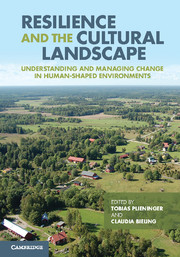 Resilience and the Cultural Landscape
Resilience and the Cultural Landscape Book contents
- Frontmatter
- Contents
- List of contributors
- Preface
- Part I Conceptualising landscapes as social–ecological systems
- Part II Analysing landscape resilience
- Part III Managing landscapes for resilience
- 12 Collective efforts to manage cultural landscapes for resilience
- 13 Response strategy assessment: a tool for evaluating resilience for the management of social–ecological systems
- 14 Ecosystem services and social–ecological resilience in transhumance cultural landscapes: learning from the past, looking for a future
- 15 The role of homegardens in strengthening social–ecological resilience: case studies from Cuba and Austria
- 16 Promises and pitfalls of adaptive management in resilience thinking: the lens of political ecology
- Part IV Perspectives for resilient landscapes
- Index
- References
15 - The role of homegardens in strengthening social–ecological resilience: case studies from Cuba and Austria
Published online by Cambridge University Press: 05 November 2012
- Frontmatter
- Contents
- List of contributors
- Preface
- Part I Conceptualising landscapes as social–ecological systems
- Part II Analysing landscape resilience
- Part III Managing landscapes for resilience
- 12 Collective efforts to manage cultural landscapes for resilience
- 13 Response strategy assessment: a tool for evaluating resilience for the management of social–ecological systems
- 14 Ecosystem services and social–ecological resilience in transhumance cultural landscapes: learning from the past, looking for a future
- 15 The role of homegardens in strengthening social–ecological resilience: case studies from Cuba and Austria
- 16 Promises and pitfalls of adaptive management in resilience thinking: the lens of political ecology
- Part IV Perspectives for resilient landscapes
- Index
- References
Summary
Introduction
Worldwide homegardens are an integral part of rural and urban social–ecological systems. Often these gardens are small, not market orientated, not easily detected by outsiders and managed through low input practices. These might be reasons why they are neglected in agronomic research. In comparison, landscape planning and urban planning do focus on gardens, often from a recreational or environmentalist point of view, but highlighting less their important multifunctional contributions to the owning household and the community as a whole. Links between homegardens and the resilience of homegarden managers, their livelihood systems and rural landscapes still remain under-explored. To bridge this gap, this chapter investigates how homegardens contribute to increase social–ecological resilience of homegarden owners and the local community as a reaction to political and socioeconomic changes in Cuba and Austria.
The Cuban context
Many Cubans have witnessed the revolution in 1959, the US trade embargo since 1961 and the economic crisis, termed ‘Special Period’, following the collapse of the Soviet Union. These political events served to create constant changes in their lives, as regards changes in laws and living conditions, food security, access to markets and even religious freedom. Cubans also endure hurricanes on a regular basis.
- Type
- Chapter
- Information
- Resilience and the Cultural LandscapeUnderstanding and Managing Change in Human-Shaped Environments, pp. 261 - 282Publisher: Cambridge University PressPrint publication year: 2012
References
- 2
- Cited by


